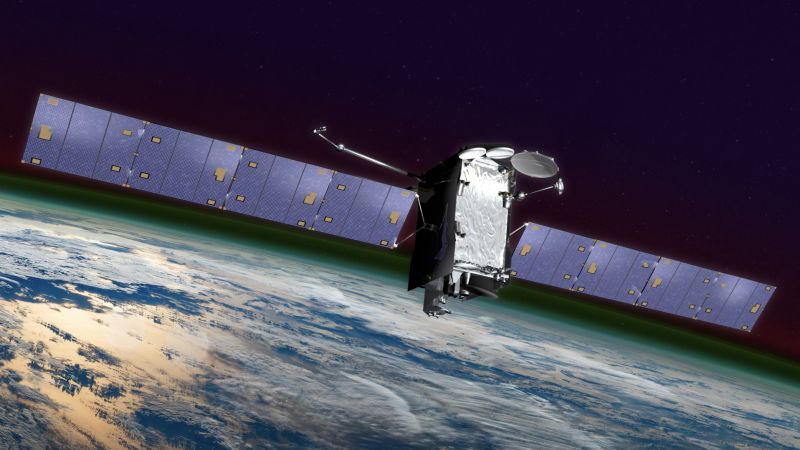Sign up for CNN’s Wonder Theory science newsletter. Explore the universe with news on fascinating discoveries, scientific advancements and more.
CNN
—
Each day, radio signals from key communications and navigation satellites travel freely through a layer of Earth’s atmosphere known as the ionosphere.
Floating 50 to 400 miles (80 to 643 kilometers) above our heads, directly beneath the lowest reaches of space where some communications satellites orbit, this zone in the upper atmosphere is also home to many unsolved puzzles — including an alphabet-shaped one that has the potential to thwart all that those radio signals do to keep life on our planet running smoothly.
Astronomers have known for some time that X-shaped crestlike formations can appear in the ionosphere’s plasma — a sea of charged particles — after solar storms.
Volcanic events and extreme weather on Earth can also cause the phenomenon. Huge eruptions, such as the Hunga Tonga-Hunga Ha’apai eruption in January 2022, loft particles into Earth’s atmosphere that even reach space. Thunderstorms and hurricanes can create pressure waves that find their way to the ionosphere.
Meanwhile, at night during these active periods, when the sun’s radiation isn’t as strong, is also when low-density bubbles appear in the ionosphere.
Satellite data hasn’t always been able to capture the full picture of what’s occurring in the ionosphere, but NASA’s GOLD mission has a bird’s-eye view of the atmospheric layer over the Western Hemisphere from space, revealing how different factors cause disturbances in the ionosphere.
Now, astronomers looking at data collected by the GOLD mission have found similar features shaped like Xs and never-before-seen Cs that surprisingly seem to have appeared during “quiet times” when there were no atmospheric disturbances, according to new research. The findings are upending what’s known about how the unusual structures might form and their potential impacts.
The mission’s data is helping scientists to see “how complex Earth’s atmosphere is” while showing that it’s more variable than expected, even when there isn’t an obvious cause behind the alphabet-shaped disturbances in the ionosphere, said Jeffrey Klenzing, a research scientist who studies the ionosphere at NASA’s Goddard Space Flight Center in Greenbelt, Maryland.
“I would suspect that it’s always been happening,” he said. “And really the issue has basically been that we haven’t had enough data to really see that it is happening.”
Gaining a better understanding of the letter-shaped phenomena may help scientists unlock the dynamics between the ionosphere and weather — and how the interplay may pose risks to people and systems on Earth.
X-shaped crests
The ionosphere is not always a perfectly smooth layer of gas, and it’s constantly changing. It becomes electrified when sunlight hits it. Solar radiation knocks electrons off atoms and molecules to create plasma that allows radio communications to travel over long distances.
But as the sun fades away at night, the ionosphere thins out and the once-charged particles settle down and become neutral particles, according to NASA. This is when bubbles can form in the ionosphere.
Earth’s magnetic field lines also carry charged particles free-floating in the atmosphere to two dense bands north and south of the equator that are known as crests.
Given their various densities, crests and bubbles resembling different shapes within the ionosphere can cause interference with communication and GPS signals.
The GOLD, or Global-scale Observations of the Limb and Disk, mission has been monitoring the ionosphere since it launched in January 2018. The satellite zips around Earth at the same rate that our planet rotates, enabling the spacecraft to remain in a constant hover over the Western Hemisphere.
GOLD spotted the clearest signs of the X- and C-shaped features in 2019, 2020 and 2021 — and in unexpected places. The evidence is causing researchers to question the potential effects of the Xs and Cs on communication signals in the future.
“NASA’s GOLD mission is the first one to observe the alphabetical shapes unambiguously,” said Fazlul Laskar, lead author of an April study about the X shapes published in the Journal of Geophysical Research: Space Physics.
“These shapes reveal that the ionosphere can be very dynamic at times displaying unexpected structures,” added Laskar, a research scientist at the University of Colorado’s Laboratory for Atmospheric and Space Physics. “Also, it demonstrates that the lower atmospheric weather could have enormous impact on the ionosphere.”
GOLD observing multiple instances of the Xs forming “during geomagnetic quiet conditions” — instead of during atmospheric disturbances such as solar storms or terrestrial weather, when they were previously seen — now tells scientists some other mechanism must be responsible for forming the shapes, Laskar said. Computer models point to changes in the lower atmosphere pulling plasma downward as a possible explanation, according to the study.
“The (appearance of the) X is odd because it implies that there are far more localized driving factors,” Klenzing said. He was not involved in the April study. “This is expected during the extreme events, but seeing it during ‘quiet time’ suggests that the lower atmosphere activity is significantly driving the ionospheric structure.”
Never-before-seen C bubbles
Separately, GOLD also observed C-shaped plasma bubbles that may be influenced by other factors.
Typically, plasma bubbles are long and straight because they form along Earth’s magnetic field lines. But some of the bubbles resemble curved shapes, which look like Cs or reverse Cs, and scientists think they could be shaped by Earth’s winds.
While C shapes may form if winds increase with altitude, reverse Cs could form if winds decrease with altitude, according to research models.

“It’s a little like a tree growing in a windy area,” Klenzing said. “If the winds are typically to the east, the tree starts to tilt and grow in that direction.”
But GOLD observed C-shaped and reverse C-shaped plasma bubbles unusually close together, only about 400 miles (644 kilometers) apart, or the about distance between Baltimore and Boston, according to a November 2023 study published in the Journal of Geophysical Research: Space Physics.
“Within that close proximity, these two opposite-shaped plasma bubbles had never been thought of, never been imaged,” said Deepak Karan, research scientist at the University of Colorado’s Laboratory for Atmospheric and Space Physics. Karan works on the GOLD mission and is the lead author of the C-shape study and coauthor of the X-shape study.
Tornado-like activity, wind shear or a vortex could be creating turbulence in the atmosphere that causes changing wind patterns in such a small area, Karan said. But they never expected to see such oppositely structured bubbles so close together.
“The fact that we have very different shapes of bubbles this close together tells us that the dynamics of the atmosphere is more complex than we expected,” Klenzing said.
So far, GOLD has only observed two instances of the close pairings, but the C-shaped bubbles have the potential to disrupt communications.
“It’s really important to find out why this is happening,” Karan said. “If a vortex or a very strong shear in the plasma has happened, this will completely distort the plasma over that region. Signals will be lost completely with a strong disturbance like this.”
Karan said these vortices, which can last for hours, resemble tornadoes that occur in Earth’s lower atmosphere, but the puzzle scientists can’t seem to solve is how the structures form in the ionosphere during “quiet time.”
“Unraveling the mystery of these plasma bubble formations is not only a scientific curiosity but also of practical importance for mitigating the adverse effects on communication and navigation systems,” he said.
Attempts to understand how the bubbles form so close together with current modeling tools has been unsuccessful, Karan said. It is his hope that by publishing the research and including all possible formation mechanisms, the scientific community can come together to solve the mystery.
A golden trove of data
The GOLD mission is well suited to capture unexpected features in the ionosphere because of its orbit. While previous satellite missions could only capture a small piece of an event in one dimension, GOLD can take multiple images of an event over the course of hours, Laskar said. And he expects even more surprising features to be revealed in GOLD’s data in the future.
“Due to such wide view and continuous measurements, GOLD has allowed us to observe these mysteries within the ionosphere,” Karan said.
He said there are many questions that remain unanswered about this atmospheric layer, such as how changes in the lower atmosphere and solar activity influence the motion of charged particles in the ionosphere.
Given that solar storms could increase due to the sun approaching the peak of its 11-year cycle, called solar maximum, astronomers also want to have a better understanding of how the ionosphere’s composition changes during the events because sudden swells of charged particles can increase drag on satellites and shorten their lifespans, Karan said.
Electric currents also flow in the ionosphere, and an increase in the electric current during solar storms can damage transmission lines and ground transformers on Earth, he said.
During the May 10 geomagnetic storm that hit Earth, tractor company John Deere reported that some customers reliant on GPS for precision farming experienced a disruption.
“The biggest impact to the agriculture industry centered on GPS guidance systems,” said Tim Marquis, a senior product manager at John Deere, in a statement. “GPS receivers work when a signal is received at regular intervals, much like a beat from a metronome, from a satellite in orbit. During solar storms, that signal hits a ‘fog’ of charged particles and can be lost. And machines can’t know precisely where they are thanks to this interference.”
Pending results from studies of GOLD data during the May 10 geomagnetic storm could help astronomers in the development of a space weather forecasting system, Laskar said.
“One thing we need to have is a space weather forecasting system that could tell us when we are going to have problems with GPS signals and when satellite orbits may need to be adjusted to avoid catastrophic collisions,” he said.
Losing a GPS signal on Earth isn’t just annoying for people trying to find a location they’ve never been to. The navigation signals are widely used in shipping, transportation, agriculture and construction, too.
When bubbles, crests or solar storms disrupt the plasma distribution in the ionosphere, radio signals passing through the atmospheric layer can be changed, lost or fade away, Karan said.
“There could be life-threatening impacts due to the sudden loss of GPS signals in aircraft, ships, and automobiles which is even scary to imagine,” he said.
GOLD and future mission concepts could help scientists to better understand the phenomena at work behind these recently observed X and C features — and even perhaps predict such changes before they occur in the ionosphere.
“One of the challenges for ionospheric researchers is to eventually be able to predict its dynamics in advance,” Laskar said, “so that we can be prepared for GPS signal loss and interruptions to satellite communications.”








